Love traditional Puerto Rican Pasteles? Then you will love these Pasteles de Arroz (Rice Pasteles)! These are just so delicious and the flavor will remind you so much of traditional Puerto Rican Pasteles! Perfect for the holidays!

Like Mofongo, Pasteles is another quintessential dish of Puerto Rico. It is a dish loved by many including of course myself!
However, sometimes depending on where you live, it’s not always easy to find all the ingredients you need which led me to make and share these unconventional but absolutely delicious pasteles with you!
These Rice Pasteles are not only much easier to make but will require ingredients and materials that are more seemingly within your reach!
What are Puerto Rican Pasteles?
Firstly, if you are unfamiliar with traditional pasteles, it is important to know that although this dish is made and served anytime of the year, you will specifically find them around the holidays; from Thanksgiving, Christmas through Three Kings Day.
Puerto Rican Pasteles are made out of a vegetable masa which is quite honestly pretty labor intensive to make. Although, incredibly worth the endeavor!
The masa is then filled with a savory filling which traditionally is made of pork.
It is then wrapped within a plantain leaf and special paper made for wrapping pasteles. The pasteles are then wrapped with twine and boiled.

Where Did Pasteles de Arroz Originate From
Pasteles de arroz or Pastelitos de Arroz (Mini Rice Pasteles) originated from the town of Corozal, Puerto Rico.
Traditionally, they’re not the size of regular pasteles, hence pastelitos de arroz. Instead, these pasteles are about 3-4 inches in length. A truly delicious little morsel wrapped in a plantain leaf!
However, feel free to make these a full pastel size if you like!
Ingredients
For Meat Filling
- 2 pounds pork shoulder, butt, roast or boneless ribs
- 3 tablespoon Puerto Rican sofrito
- 6 garlic cloves
- 1 tablespoon garlic powder
- ½ tablespoon oregano
- ½ tablespoon cumin
- 1 packet of Sazon with Annatto
- salt to taste
- ⅓ cup tomato sauce
- 1 cup water
- ½ cup vinegar
- handful of fresh cilantro (about 4 tbsp)
- 1 tablespoon annatto oil (achiote oil) (very easy recipe)
- 1 tablespoon vegetable oil
- 15 or so olives or to your liking (optional)
- ⅓ cup garbanzo beans (optional)
- 2-3 tablespoon roasted pimiento peppers (optional)
Please note, to make annatto oil, you will need 2-3 tablespoon of annatto seeds found in the Latin section of supermarkets or online store such as Amazon.
Other Ingredients
- 1½-2 green plantains, grated
- 2 cups medium or long grain rice
- hot sauce and ketchup for serving
Materials Needed
- Plantain Leaves
- Pasteles Paper or Parchment Paper
- Twine

How to Make Pasteles de Arroz (Rice Pasteles)

Rice: It is important to presoak your rice in water for a minimum of 2 hours or overnight. This will be the first step before proceeding to any other step of recipe.
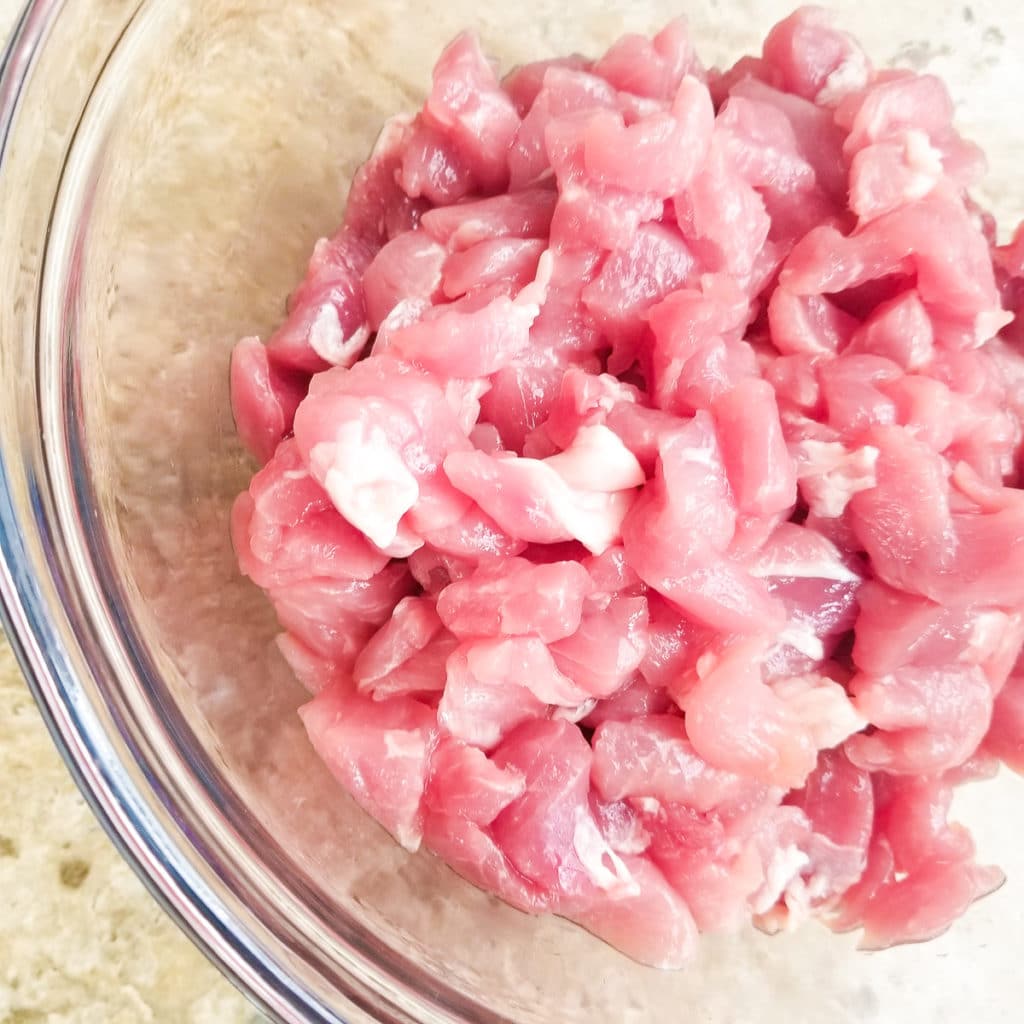

Pork: Rinse pork under cool water and cut into ½ inch cubes.
Soaking pork: Although not necessary, it is a good idea to soak pork cubes in vinegar for 20 minutes as this will quickly help to tenderize it. Then rinse pork well.
Cooking pork: Add a tablespoon of vegetable oil to a pot over medium heat.
Add pork and sear for a few minutes.
Spices: Add the fresh garlic, sofrito, garlic powder, cumin, oregano, Sazon, tomato sauce, cilantro, olives, garbanzo beans, pimiento peppers and one cup of water. Add salt to taste. Stir and cook for 30 minutes over medium heat.


- After 30 minutes, add 2 tablespoons of achiote/annatto oil to pork and stir.
- Continue cooking pork for another 30 minutes or until pork is tender.
- Taste for seasoning, add additional salt if needed.


- Using a grater, grate plantains on it’s finest side.

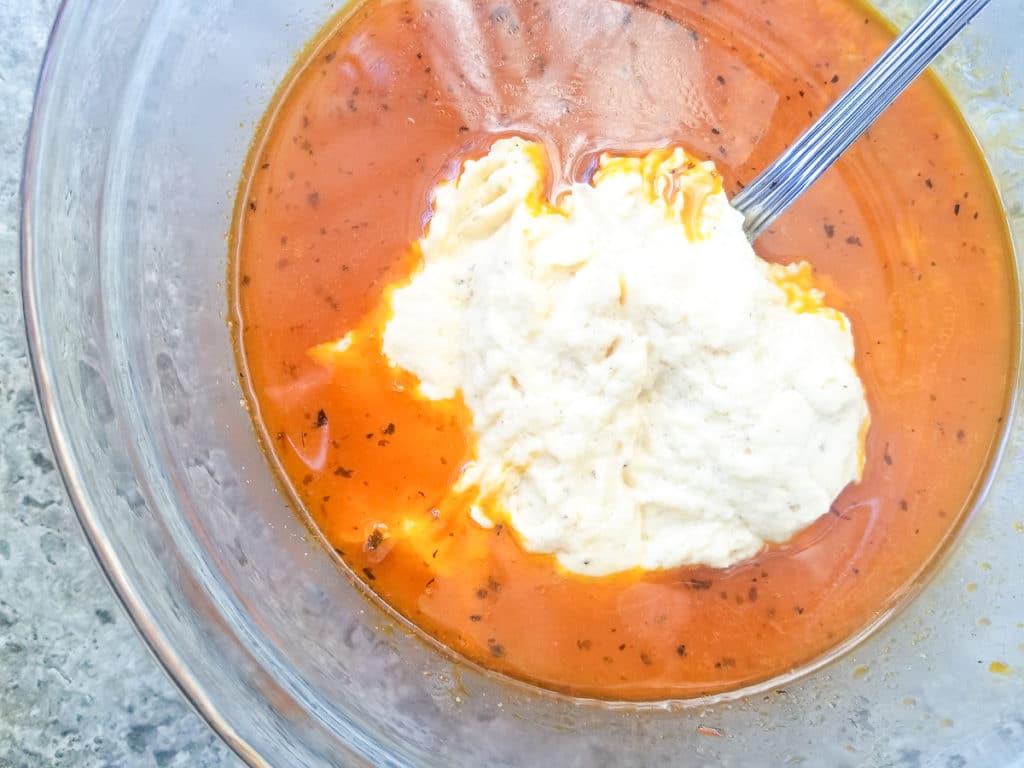
Rice
- After a minimum of two hours of rice soaking, drain water and add 1½ cups of broth from pork. Stir.
- Add grated plantain puree.

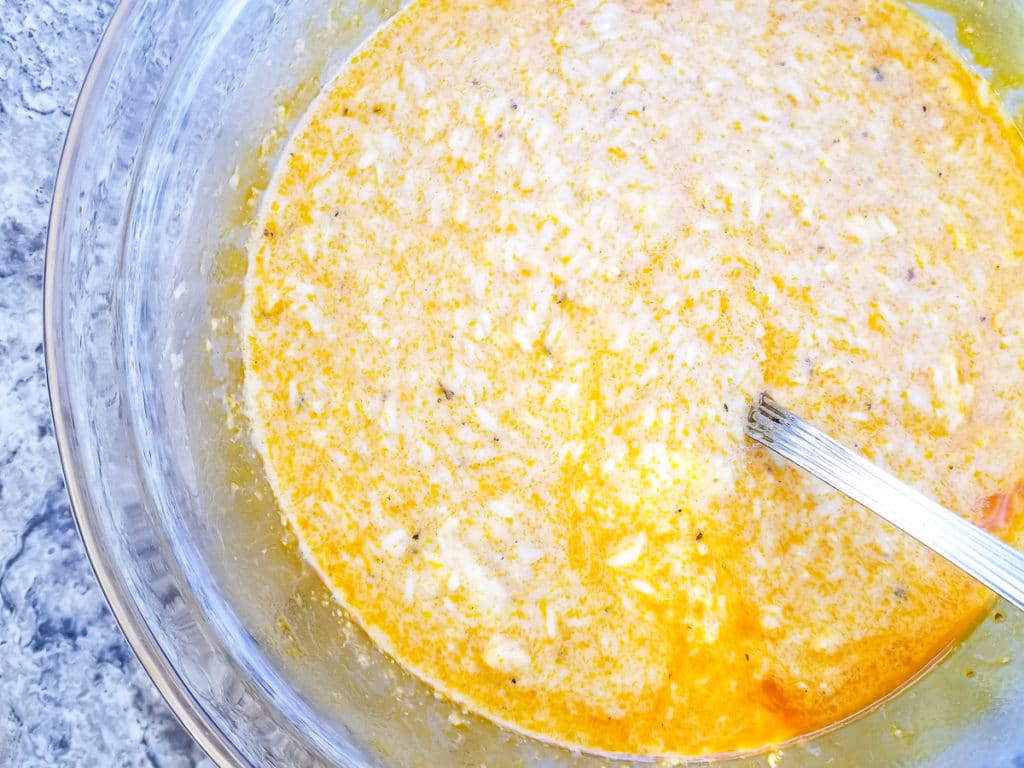
- Stir plantain puree into rice and allow rice to continue soaking until ready to use.
Preparing Plantain Leaves


- Remove plantain leaves from package and cut 30 pieces into 6×8 inch pieces.
- Under warm water rinse each leaf on both sides. Continue with either one of the two steps below.
To make leaves pliable and manageable, you will need to do 1 of 2 options.
Option 1:
- After rinsing leaves, turn stove on.
- Taking one leaf at a time, briefly score leaf over burner on both sides.
- Proceed until all leaves are done.
- Wipe each leaf with a damp cloth. Set leaf aside until ready to use.
Option 2:
- In a medium size pot, add enough water to cover plantain leaves. Allow water to come to a boil and add about ½ teaspoon of salt to water. Add leaves to pot. Let leaves soak in water for 5 minutes.
- Turn off pot. Remove leaves and wipe each leaf with a cloth or paper towel on both sides to dry.
- Set leaves aside until ready to use.
Paper
- If you cannot find ready to use pasteles paper, simply use parchment paper.
- Cut 30 pieces into 12×16 inch.
Twine
- Cut 30 pieces of twine. Each piece measuring 3 yards.
Now all your materials are ready to make rice pasteles!

Making the Pasteles de Arroz


- Have your rice, pork filling, paper, plantain leaves and twine side by side.
Lets begin…
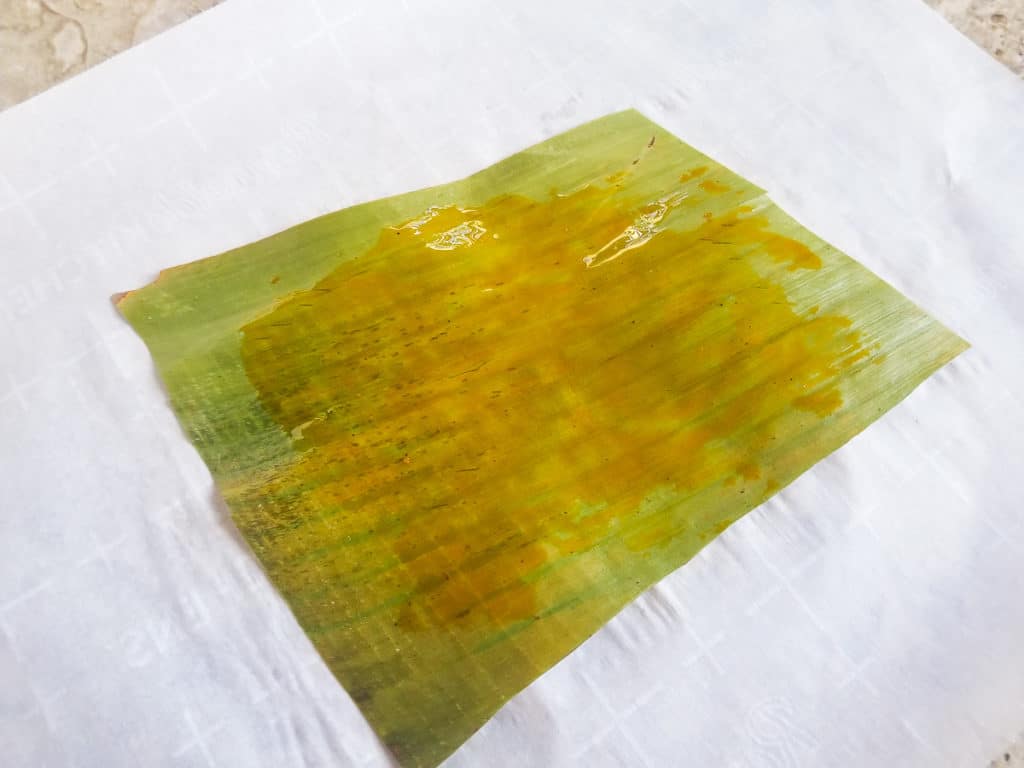


- Place your parchment paper on a flat surface. Add plantain leaf and proceed with adding a teaspoon of achiote oil to leaf.
- Using the back of a spoon, spread the achiote oil to cover surface of plantain.
- Add 2 tablespoons of rice mixture to leaf and spread lengthwise.
- Follow by two tablespoons of pork mixture.
- Top with additional olives and roasted pepper pimiento if wanted.



- Bring parchment paper over mixture and continue rolling over to fully enclose mixture snugly.


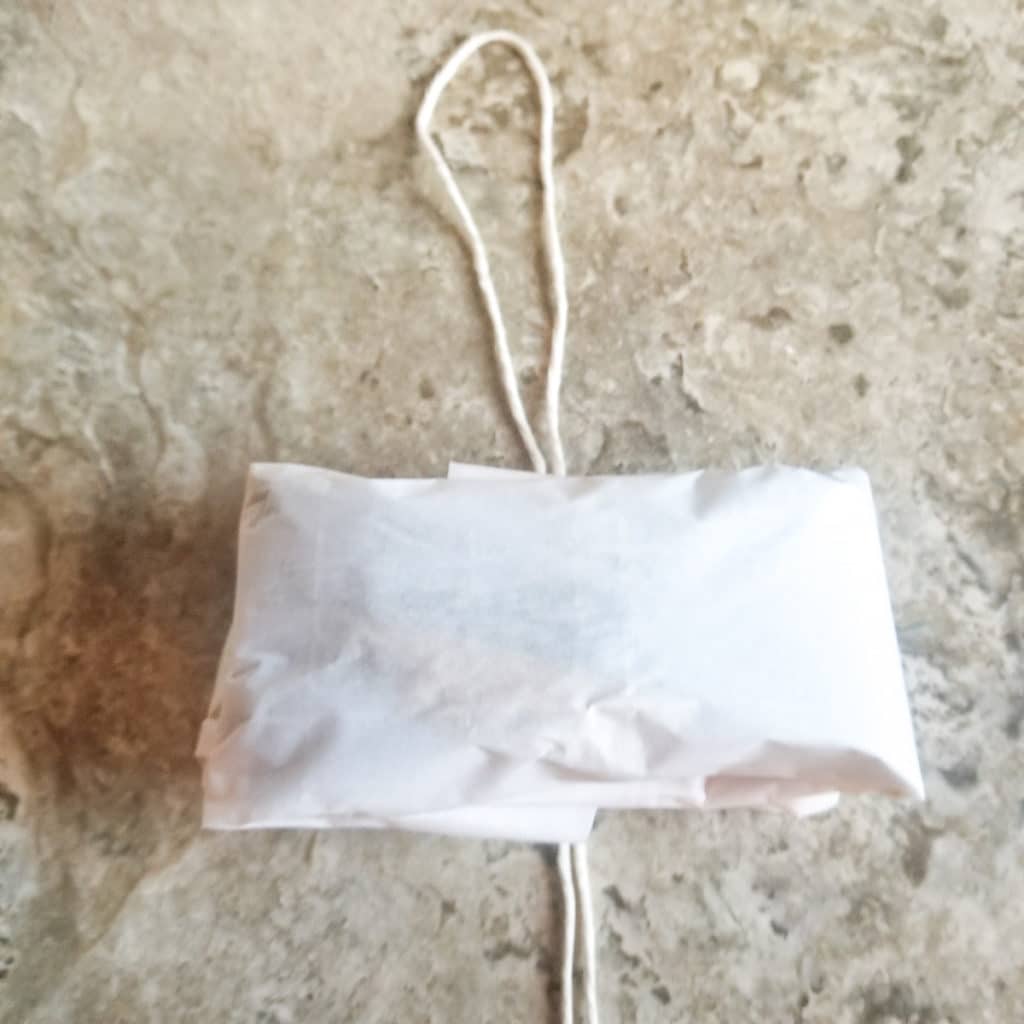
- Fold one side of parchment paper underneath pastel and repeat procedure with the other end.
NOTE: At this point you con individually tie pastel(es) or continue making the other pasteles and then stack two at a time together before tying with twine.
- Fold twine in half and place underneath pastel to form a hoop.


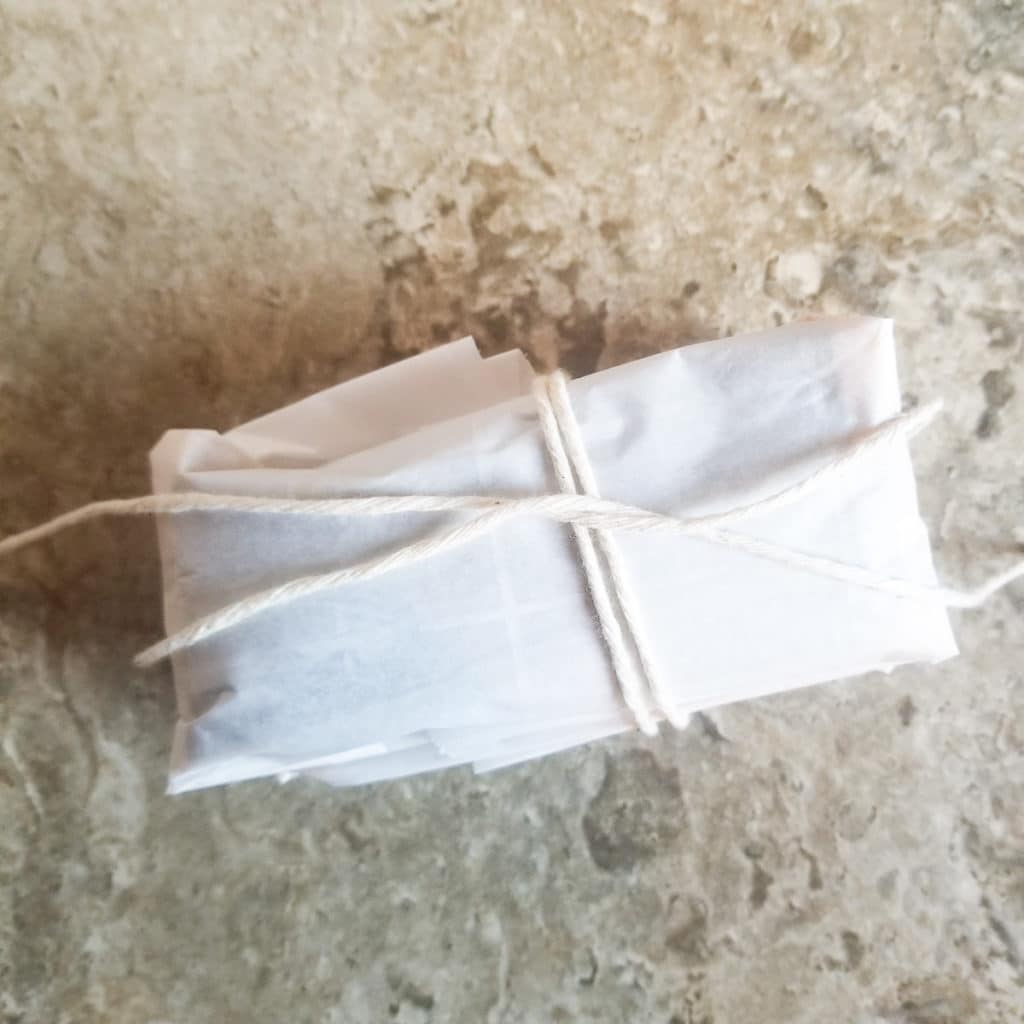
- String twine through center of hoop in twine and snug pastel.
- Bring the ends over to other sides of pastel and go underneath pastel with twine.
- Flip pastel over and repeat procedure again.



- Finally tie a knot to keep pasteles secure and snug.
Note: Do not squeeze pasteles with twine too much as when they cook, the rice will swell up and needs slight space to fluff.

The picture above shows stacks of 2 pasteles to a bundle. Here I have already made 10 pasteles.

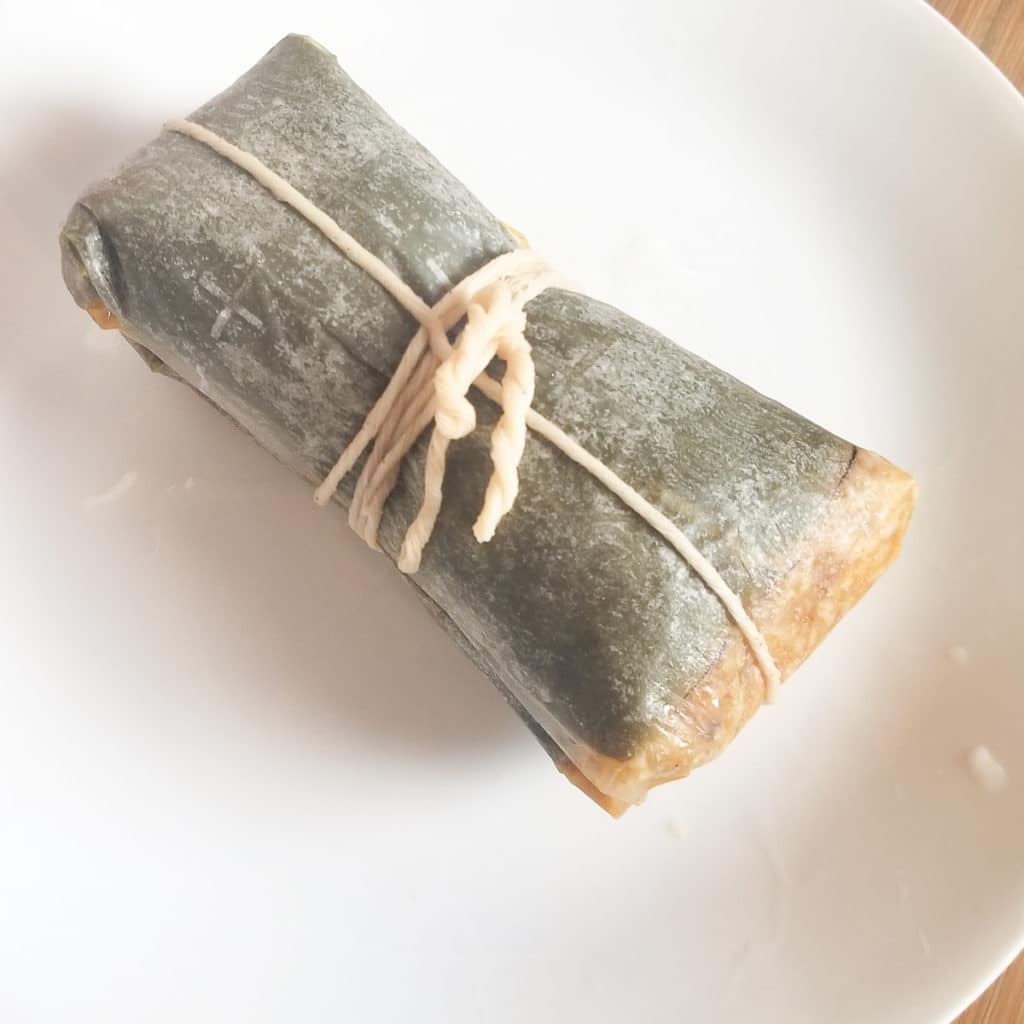

- At this point you can either cook pasteles right away or you can freeze them.
To Cook Pasteles de Arroz (Rice Pasteles)
- In a medium to large pot, over medium high heat, add enough water to cover pasteles.
- Add about a teaspoon of salt to water.
- Cover pot and cook for a minimum of 1 hr. Preferably 1½ hours.
Serving
- When pasteles are cooked, using tongs or a fork, remove pastel bundles from water allowing excess water to drain from pasteles.
- Place on a plate. Using scissors, cut twine. Open ends of paper and roll pastel out.
- Discard paper and either serve pastel on top of plantain leaf or discard as well.
- Serve pasteles with a side of hot sauce and ketchup.
- Enjoy!

How to Store Pasteles de Arroz
Once you have made all your pasteles, you can freeze them.
If you are planning on eating the pasteles really soon, simply stack them in your freezer one on top of another.
For longer storage, I prefer to place them in a large gallon ziploc bag or freezer safe container for easier storage and extra protection from the freezer elements.
Pasteles will last in freezer covered for up to six months.
How to Cook Pasteles from Frozen
Take however many pasteles de arroz you are planning on having for yourself and family and place in a large pot with enough water to cover.
Add a teaspoon of salt to water and cook over medium high heat for an hour and a half covered.

Other Puerto Rican Holiday Foods
Pernil (Roast Pork Shoulder) (coming soon)
Pavochon (Puerto Rican Style Turkey
Arroz con Gandules (Pigeon Peas and Rice)
Ensalada de Papa (Puerto Rican Potato Salad)
Ensalada de Coditos (Puerto Rican Macaroni Salad)
Sweet Potato Casserole (Cazuela de Batatas)
Did you try this recipe? Please leave a ⭐ review below!
Click any of the images in the post to PIN this Recipe and don't forget to follow along on Pinterest and Facebook.
📖 Recipe

Pasteles de Arroz (Rice Pasteles)
Ingredients
Pork Filling
- 3 pounds pork shoulder, butt, roast or boneless ribs rinsed and cut into ½ inch cubes
- 3 tablespoon Puerto Rican sofrito
- 6 cloves garlic mashed
- 1 tablespoon garlic powder
- ½ tablespoon oregano
- ½ tablespoon cumin
- 1 packet Sazon with Annatto found in Latin section of supermarket
- ⅓ cup tomato sauce
- salt to taste
- 1 cup water
- ½ cup vinegar
- handful fresh cilantro
- 1 tablespoon annatto oil/achiote oil
- 1 tablespoon vegetable oil
- 3 tablespoon pimiento stuffed olives optional
- ⅓ cup garbanzo beans optional
- 2-3 tablespoon roasted pimiento peppers optional
Other Ingredients
- 1½-2 green plantains peeled and grated
- 2 cups medium or long grain rice
- hot sauce and ketchup for serving
Materials Needed
- 1 package plantain leaves
- pasteles paper or parchment paper
- twine
- grater
Instructions
Presoak Rice
- Rinse rice under cool running water.Place rice in a bowl and presoak in 2 cups hot water for a minimum of 2 hours or overnight.
Getting Pork Ready for Filling
- Rinse pork under cool water and cut into ½ inch cubes.
- Although this step is not necessary, it is a good idea to soak pork cubes in vinegar for 20 minutes as this will quickly help to tenderize it. Then rinse pork well.
Cooking Pork
- Add a tablespoon of vegetable oil to a pot over medium heat.Add pork and sear for a few minutes.
- Add the fresh garlic, sofrito, garlic powder, cumin, oregano, Sazon, tomato sauce, cilantro, olives, garbanzo beans, pimiento peppers and one cup of water. Add salt to taste. Stir and cook for 30 minutes over medium heat.
- After 30 minutes, add 2 tablespoons of achiote/annatto oil to pork and stir.
- Continue cooking pork for another 30 minutes or until pork is tender.Taste for seasoning, add additional salt if needed.
Grating Plantain(s)
- Using a grater, grate plantains on it's finest side.
- After a minimum of two hours of rice soaking, drain water and add 1½ cups of broth from pork. Stir.
- Add grated plantain puree.Stir plantain puree into rice and allow rice to continue soaking until ready to use.
Preparing Plantain Leaves
- Remove plantain leaves from package and cut 30 pieces into 6×8 inch pieces.
- Under warm water rinse each leaf on both sides.
Make Leaves Pliable
- Option 1After rinsing leaves, turn stove on.Taking one leaf at a time, briefly score leaf over burner on both sides. Proceed until all leaves are done.Wipe each leaf with a damp cloth. Set leaf aside until ready to use.
- Option 2In a medium size pot, add enough water to cover plantain leaves. Allow water to come to a boil and add about ½ teaspoon of salt to water. Add leaves to pot. Let leaves soak in water for 5 minutes.Turn off pot. Remove leaves and wipe each leaf with a cloth or paper towel on both sides to dry.Set leaves aside until ready to use.
Paper for Pasteles
- If you cannot find ready to use pasteles paper, simply use parchment paper.Cut 30 pieces into 12×16 inch.
Twine
- Cut 30 pieces of twine. Each piece measuring 3 yards.
Forming Pasteles de Arroz
- Have your rice, pork filling, paper, plantain leaves and twine side by side.
- Place your parchment paper on a flat surface. Add plantain leaf and proceed with adding a teaspoon of achiote oil to leaf.
- Using the back of a spoon, spread the achiote oil to cover surface of plantain.
- Add 2 tablespoons of rice mixture to leaf and spread lengthwise.
- Add two tablespoons of pork mixture to the center of rice masa.
- Top with additional olives, garbanzo beans and roasted pimiento pepper if wanted.
Folding Pasteles de Arroz
- (Refer to pictures for next steps)Bring parchment paper over mixture and continue rolling over to fully enclose mixture snugly.
- Fold one side of parchment paper underneath pastel and repeat procedure with the other end.NOTE: At this point you con individually tie pastel(es) or continue making the other pasteles and then stack two at a time to form a bundle of two together before tying with twine.
- Fold twine in half and place underneath pastel to form a hoop.
- String twine through center of hoop in twine and snug pastel.
- Bring the ends over to other sides of pastel and go underneath pastel with twine.
- Flip pastel over and repeat procedure again.
- Finally tie a knot to keep pasteles secure and snug.Note: Do not squeeze pasteles with twine too much as when they cook, the rice will swell up and needs slight space to fluff.
- At this point you can either cook pasteles right away or you can freeze them. (Refer to post for freezin pasteles)
Cooking Pasteles
- In a medium to large pot, over medium high heat, add enough water to cover pasteles.
- Add about a teaspoon of salt to water.
- Cover pot and cook for a minimum of 1 hr. Preferably 1½ hours.
Serving Pasteles de Arroz
- When pasteles are cooked, using tongs or a fork, remove pastel bundles from water allowing excess water to drain from pasteles.
- Place on a plate. Using scissors, cut twine. Open ends of paper and roll pastel out.
- Discard paper and either serve pastel on top of plantain leaf or discard as well.
- Serve pasteles with a side of hot sauce and ketchup.Enjoy!







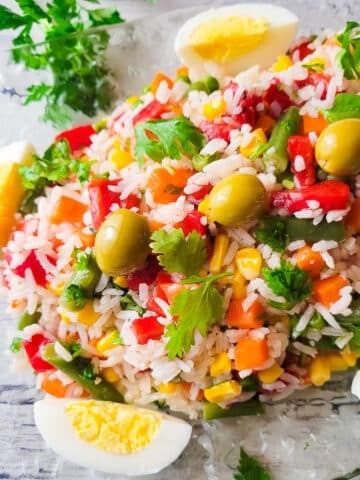

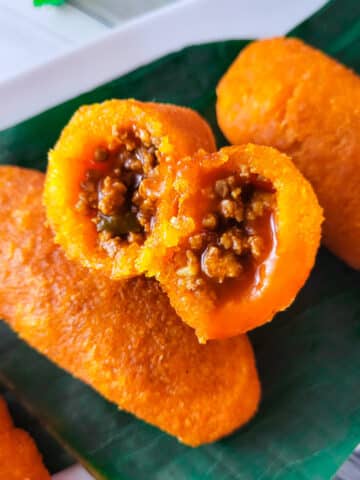

Join the Discussion